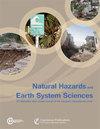Testing machine learning models for heuristic building damage assessment applied to the Italian Database of Observed Damage (DaDO)
IF 4.7
2区 地球科学
Q1 GEOSCIENCES, MULTIDISCIPLINARY
引用次数: 0
Abstract
Abstract. Assessing or forecasting seismic damage to buildings is an essential issue for earthquake disaster management. In this study, we explore the efficacy of several machine learning models for damage characterization, trained and tested on the database of damage observed after Italian earthquakes (the Database of Observed Damage – DaDO). Six models were considered: regression- and classification-based machine learning models, each using random forest, gradient boosting, and extreme gradient boosting. The structural features considered were divided into two groups: all structural features provided by DaDO or only those considered to be the most reliable and easiest to collect (age, number of storeys, floor area, building height). Macroseismic intensity was also included as an input feature. The seismic damage per building was determined according to the EMS-98 scale observed after seven significant earthquakes occurring in several Italian regions. The results showed that extreme gradient boosting classification is statistically the most efficient method, particularly when considering the basic structural features and grouping the damage according to the traffic-light-based system used; for example, during the post-disaster period (green, yellow, and red), 68 % of buildings were correctly classified. The results obtained by the machine-learning-based heuristic model for damage assessment are of the same order of accuracy (error values were less than 17 %) as those obtained by the traditional RISK-UE method. Finally, the machine learning analysis found that the importance of structural features with respect to damage was conditioned by the level of damage considered.在意大利观测损伤数据库(DaDO)上测试启发式建筑损伤评估的机器学习模型
摘要建筑物震害评估或预测是地震灾害管理的一个重要问题。在本研究中,我们探索了几种机器学习模型在意大利地震后观察到的损伤数据库(DaDO)上进行训练和测试的效果。考虑了六种模型:基于回归和分类的机器学习模型,每种模型都使用随机森林、梯度增强和极端梯度增强。考虑的结构特征被分为两组:DaDO提供的所有结构特征或仅被认为是最可靠和最容易收集的结构特征(年龄,层数,建筑面积,建筑高度)。宏观地震烈度也作为输入特征。根据在意大利几个地区发生七次大地震后观察到的EMS-98震级,确定了每座建筑物的地震破坏程度。结果表明,极端梯度增强分类是统计上最有效的方法,特别是当考虑基本结构特征并根据使用的红绿灯系统对损伤进行分组时;例如,在灾后时期(绿色、黄色和红色),68%的建筑被正确分类。基于机器学习的启发式损伤评估模型得到的结果与传统的RISK-UE方法具有相同的精度数量级(误差值小于17%)。最后,机器学习分析发现,结构特征相对于损伤的重要性取决于所考虑的损伤水平。
本文章由计算机程序翻译,如有差异,请以英文原文为准。
求助全文
约1分钟内获得全文
求助全文
来源期刊
CiteScore
7.60
自引率
6.50%
发文量
192
审稿时长
3.8 months
期刊介绍:
Natural Hazards and Earth System Sciences (NHESS) is an interdisciplinary and international journal dedicated to the public discussion and open-access publication of high-quality studies and original research on natural hazards and their consequences. Embracing a holistic Earth system science approach, NHESS serves a wide and diverse community of research scientists, practitioners, and decision makers concerned with detection of natural hazards, monitoring and modelling, vulnerability and risk assessment, and the design and implementation of mitigation and adaptation strategies, including economical, societal, and educational aspects.

 求助内容:
求助内容: 应助结果提醒方式:
应助结果提醒方式:


